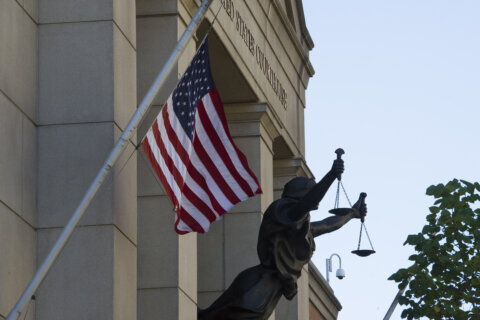RICHMOND, Va. (AP) — For more than 150 years, Virginia’s capital city greeted visitors with a landscape steeped in Confederate heritage and dotted with its relics, including a collection of enormous statues to rebel fighters.
Tucked away, or in many cases buried, was evidence of Richmond’s pivotal role in the lucrative domestic slave trade. Hundreds of thousands of men, women and children were jailed, bought and sold in the city, and shipped across the South in the decades preceding the Civil War.
A push to rethink that historical landscape is underway as Richmond, like other cities across the United States, grapples with how to tell a more complete version of its past and the history of Black lives. Confederate statues have fallen, and city officials announced a major funding commitment Tuesday for an ambitious and long-envisioned memorial campus in Richmond’s former slave-trading district, Shockoe Bottom.
“For hundreds of years, that story has essentially gone untold. Do we know about it? Yes. But we have not properly memorialized and commemorated the horrors of the slave trade that were the driving economic force of this city,” Mayor Levar Stoney said in an interview with The Associated Press ahead of the formal announcement.
Stoney, other city and state officials, and activists held a news conference in Shockoe Bottom to outline plans for a memorial campus composed of a museum to tell the stories of enslaved people and a park for reflection.
The city has committed $3.5 million in funding right away, Stoney said, and he will propose a capital improvement budget amendment of between $25 million and $50 million that if approved would fund the effort over a series of years.
The hope is that the city’s financial commitment will be a catalyst and can be leveraged to attract the additional funding — from the state, philanthropic interests or both — that would undoubtedly be needed to see such a project to completion, Stoney said.
Shockoe Bottom, one of the city’s oldest neighborhoods, lies in a flood-prone area along the James River east of Richmond’s main financial district and a few blocks from the historic Thomas Jefferson-designed Capitol.
By some estimates, more 300,000 enslaved people were bought and sold in the Bottom, an area now home to restaurants, clubs, parking lots and converted tobacco warehouses. For a time, the city was second only to New Orleans as a slave-trading center.
Historians and community activists have long called for a greater acknowledgement of the neighborhood’s history, most of which has been bulldozed, buried or destroyed over the years. But commemoration efforts have crawled along.
The issue rose to national attention in 2014 when then-Mayor Dwight Jones proposed a baseball stadium-centered economic development project in the area that was ultimately scuttled in the face of outrage from community members who said the area was sacred ground.
Today, remembrances to the area’s slave-trading past are tucked away in an area with limited visibility next to Interstate 95, a parking lot and a rumbling set of train tracks.
A modest set of plaques mark the archaeological remains of Lumpkin’s Slave Jail — also known as “The Devil’s Half Acre” for the brutal treatment its prisoners were subjected to. A dig there in 2008 financed primarily by the city uncovered remarkably well preserved artifacts.
Nearby, a historic Blacks-only burial ground that was once covered by a parking lot is now a vast, mostly empty expanse.
On a recent afternoon, a city trashcan was overflowing at the Lumpkin’s site while a historical marker at the burial site was so faded it was nearly illegible in an area overgrown with weeds.
State Del. Delores McQuinn, a former Richmond city councilwoman and longtime member of the Richmond Slave Trail Commission, which has played a pivotal role in uncovering much of the history about the slave trade in the city, said a key window of opportunity has opened to move the project forward. The protests unleashed after George Floyd was killed by Minneapolis police have led to calls for change but also a demand “for us to better understand our history,” she said.
“It would be a gift to future generations, and this generation,” she said of the proposed memorial park.
A similar but separate conversation is taking place about the future of Monument Avenue, where many of the city’s most prominent Confederate statues have been plucked off by heavy machinery or toppled by protesters.
The graceful residential street, part of which is a National Historic Landmark District, has undergone dramatic change since early June. Protests sparked by the death of Floyd, who was Black, prompted Stoney to arrange for all the avenue’s statues on city property to be removed.
Virginia Gov. Ralph Northam is also seeking to remove an enormous statue of Confederate Gen. Robert E. Lee on a state-owned parcel of the avenue, though a lawsuit has so far prevented him from doing so.
Formal talks about the avenue’s future haven’t officially started, though informal conversations are underway.
Stoney, who along with the entire City Council is up for reelection this fall, said he thinks the city is at an inflection point.
“In order to heal, you have to tell the full and complete story,” he said.
Copyright © 2024 The Associated Press. All rights reserved. This material may not be published, broadcast, written or redistributed.







